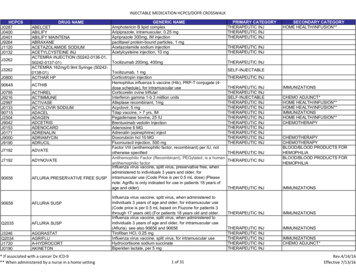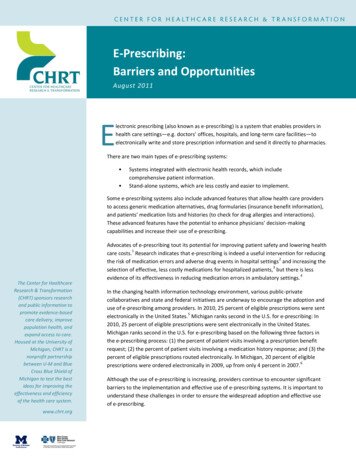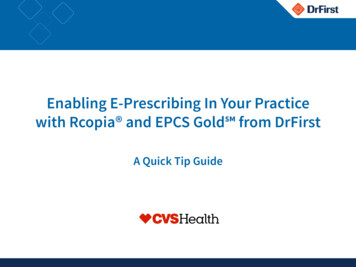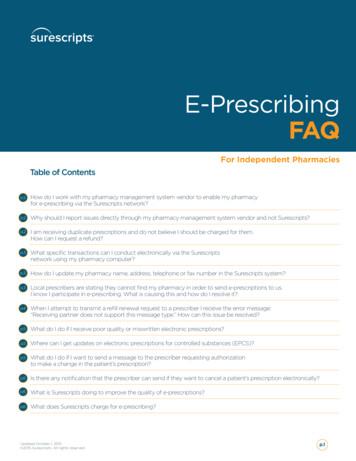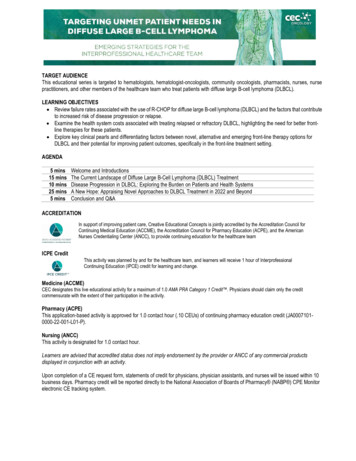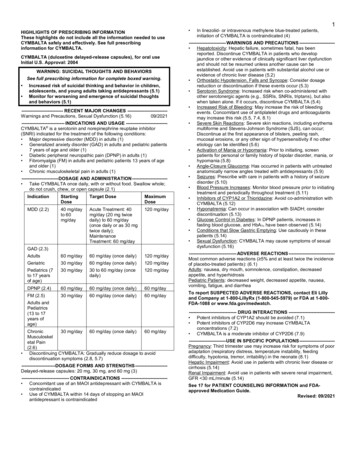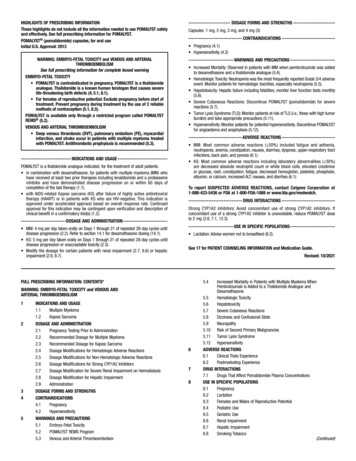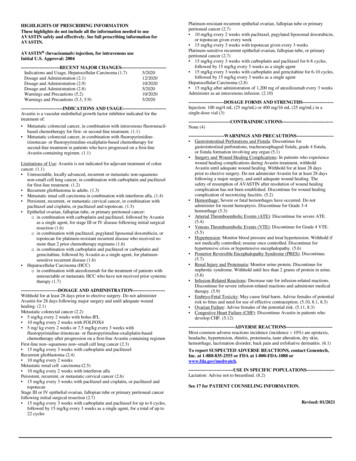
Transcription
HIGHLIGHTS OF PRESCRIBING INFORMATIONThese highlights do not include all the information needed to useAVASTIN safely and effectively. See full prescribing information forAVASTIN.AVASTIN (bevacizumab) injection, for intravenous useInitial U.S. Approval: 2004-------------------------RECENT MAJOR CHANGES----------------------------Indications and Usage, Hepatocellular Carcinoma (1.7)5/2020Dosage and Administration (2.1)12/2020Dosage and Administration (2.9)10/2020Dosage and Administration (2.8)5/2020Warnings and Precautions (5.2)10/2020Warnings and Precautions (5.3, 5.9)5/2020---------------------------INDICATIONS AND USAGE---------------------------Avastin is a vascular endothelial growth factor inhibitor indicated for thetreatment of: Metastatic colorectal cancer, in combination with intravenous fluorouracilbased chemotherapy for first- or second-line treatment. (1.1) Metastatic colorectal cancer, in combination with fluoropyrimidineirinotecan- or fluoropyrimidine-oxaliplatin-based chemotherapy forsecond-line treatment in patients who have progressed on a first-lineAvastin-containing regimen. (1.1)Limitations of Use: Avastin is not indicated for adjuvant treatment of coloncancer. (1.1) Unresectable, locally advanced, recurrent or metastatic non-squamousnon-small cell lung cancer, in combination with carboplatin and paclitaxelfor first-line treatment. (1.2) Recurrent glioblastoma in adults. (1.3) Metastatic renal cell carcinoma in combination with interferon alfa. (1.4) Persistent, recurrent, or metastatic cervical cancer, in combination withpaclitaxel and cisplatin, or paclitaxel and topotecan. (1.5) Epithelial ovarian, fallopian tube, or primary peritoneal cancer:o in combination with carboplatin and paclitaxel, followed by Avastinas a single agent, for stage III or IV disease following initial surgicalresection (1.6)o in combination with paclitaxel, pegylated liposomal doxorubicin, ortopotecan for platinum-resistant recurrent disease who received nomore than 2 prior chemotherapy regimens (1.6)o in combination with carboplatin and paclitaxel or carboplatin andgemcitabine, followed by Avastin as a single agent, for platinumsensitive recurrent disease (1.6) Hepatocellular Carcinoma (HCC)o in combination with atezolizumab for the treatment of patients withunresectable or metastatic HCC who have not received prior systemictherapy (1.7)------------------------DOSAGE AND ADMINISTRATION--------------------Withhold for at least 28 days prior to elective surgery. Do not administerAvastin for 28 days following major surgery and until adequate woundhealing. (2.1)Metastatic colorectal cancer (2.2) 5 mg/kg every 2 weeks with bolus-IFL 10 mg/kg every 2 weeks with FOLFOX4 5 mg/ kg every 2 weeks or 7.5 mg/kg every 3 weeks withfluoropyrimidine-irinotecan- or fluoropyrimidine-oxaliplatin-basedchemotherapy after progression on a first-line Avastin containing regimenFirst-line non squamous non small cell lung cancer (2.3) 15 mg/kg every 3 weeks with carboplatin and paclitaxelRecurrent glioblastoma (2.4) 10 mg/kg every 2 weeksMetastatic renal cell carcinoma (2.5) 10 mg/kg every 2 weeks with interferon alfaPersistent, recurrent, or metastatic cervical cancer (2.6) 15 mg/kg every 3 weeks with paclitaxel and cisplatin, or paclitaxel andtopotecanStage III or IV epithelial ovarian, fallopian tube or primary peritoneal cancerfollowing initial surgical resection (2.7) 15 mg/kg every 3 weeks with carboplatin and paclitaxel for up to 6 cycles,followed by 15 mg/kg every 3 weeks as a single agent, for a total of up to22 cyclesPlatinum-resistant recurrent epithelial ovarian, fallopian tube or primaryperitoneal cancer (2.7) 10 mg/kg every 2 weeks with paclitaxel, pegylated liposomal doxorubicin,or topotecan given every week 15 mg/kg every 3 weeks with topotecan given every 3 weeksPlatinum-sensitive recurrent epithelial ovarian, fallopian tube, or primaryperitoneal cancer (2.7) 15 mg/kg every 3 weeks with carboplatin and paclitaxel for 6-8 cycles,followed by 15 mg/kg every 3 weeks as a single agent 15 mg/kg every 3 weeks with carboplatin and gemcitabine for 6-10 cycles,followed by 15 mg/kg every 3 weeks as a single agentHepatocellular Carcinoma (2.8) 15 mg/kg after administration of 1,200 mg of atezolizumab every 3 weeksAdminister as an intravenous infusion. (2.10)-----------------------DOSAGE FORMS AND STRENGTHS-------------------Injection: 100 mg/4 mL (25 mg/mL) or 400 mg/16 mL (25 mg/mL) in asingle-dose vial -----------------------------None (4)-----------------------WARNINGS AND PRECAUTIONS----------------------- Gastrointestinal Perforations and Fistula: Discontinue forgastrointestinal perforations, tracheoesophageal fistula, grade 4 fistula,or fistula formation involving any organ (5.1) Surgery and Wound Healing Complications: In patients who experiencewound healing complications during Avastin treatment, withholdAvastin until adequate wound healing. Withhold for at least 28 daysprior to elective surgery. Do not administer Avastin for at least 28 daysfollowing a major surgery, and until adequate wound healing. Thesafety of resumption of AVASTIN after resolution of wound healingcomplication has not been established. Discontinue for wound healingcomplication of necrotizing fasciitis. (5.2) Hemorrhage: Severe or fatal hemorrhages have occurred. Do notadminister for recent hemoptysis. Discontinue for Grade 3-4hemorrhage (5.3) Arterial Thromboembolic Events (ATE): Discontinue for severe ATE.(5.4) Venous Thromboembolic Events (VTE): Discontinue for Grade 4 VTE.(5.5) Hypertension: Monitor blood pressure and treat hypertension. Withhold ifnot medically controlled; resume once controlled. Discontinue forhypertensive crisis or hypertensive encephalopathy. (5.6) Posterior Reversible Encephalopathy Syndrome (PRES): Discontinue.(5.7) Renal Injury and Proteinuria: Monitor urine protein. Discontinue fornephrotic syndrome. Withhold until less than 2 grams of protein in urine.(5.8) Infusion-Related Reactions: Decrease rate for infusion-related reactions.Discontinue for severe infusion-related reactions and administer medicaltherapy. (5.9) Embryo-Fetal Toxicity: May cause fetal harm. Advise females of potentialrisk to fetus and need for use of effective contraception. (5.10, 8.1, 8.3) Ovarian Failure: Advise females of the potential risk. (5.11, 8.3) Congestive Heart Failure (CHF): Discontinue Avastin in patients whodevelop CHF. (5.12)------------------------------ADVERSE REACTIONS-----------------------------Most common adverse reactions incidence (incidence 10%) are epistaxis,headache, hypertension, rhinitis, proteinuria, taste alteration, dry skin,hemorrhage, lacrimation disorder, back pain and exfoliative dermatitis. (6.1)To report SUSPECTED ADVERSE REACTIONS, contact Genentech,Inc. at 1-888-835-2555 or FDA at 1-800-FDA-1088 --USE IN SPECIFIC POPULATIONS-----------------Lactation: Advise not to breastfeed. (8.2)See 17 for PATIENT COUNSELING INFORMATION.Revised: 01/2021
FULL PRESCRIBING INFORMATION: CONTENTS*1 INDICATIONS AND USAGE1.1Metastatic Colorectal Cancer1.2First-Line Non-Squamous Non Small Cell Lung Cancer1.3Recurrent Glioblastoma1.4Metastatic Renal Cell Carcinoma1.5Persistent, Recurrent, or Metastatic Cervical Cancer1.6Epithelial Ovarian, Fallopian Tube, or PrimaryPeritoneal Cancer1.7Hepatocellular Carcinoma2 DOSAGE AND ADMINISTRATION2.1Important Administration Information2.2Metastatic Colorectal Cancer2.3First-Line Non-Squamous Non-Small Cell Lung Cancer2.4Recurrent Glioblastoma2.5Metastatic Renal Cell Carcinoma2.6Persistent, Recurrent, or Metastatic Cervical Cancer2.7Epithelial Ovarian, Fallopian Tube or Primary PeritonealCancer2.8Hepatocellular Carcinoma2.9Dosage Modifications for Adverse Reactions2.10 Preparation and Administration3 DOSAGE FORMS AND STRENGTHS4 CONTRAINDICATIONS5 WARNINGS AND PRECAUTIONS5.1Gastrointestinal Perforations and Fistulae5.2Surgery and Wound Healing Complications5.3Hemorrhage5.4Arterial Thromboembolic Events5.5Venous Thromboembolic Events5.6Hypertension5.7Posterior Reversible Encephalopathy Syndrome (PRES)5.8Renal Injury and Proteinuria5.9Infusion-Related Reactions5.10 Embryo-Fetal Toxicity5.11 Ovarian Failure5.12 Congestive Heart Failure678111213141617ADVERSE REACTIONS6.1Clinical Trials Experience6.2Immunogenicity6.3Postmarketing ExperienceDRUG INTERACTIONSUSE IN SPECIFIC POPULATIONS8.1Pregnancy8.2Lactation8.3Females and Males of Reproductive Potential8.4Pediatric Use8.5Geriatric UseDESCRIPTIONCLINICAL PHARMACOLOGY12.1 Mechanism of Action12.3 PharmacokineticsNONCLINICAL TOXICOLOGY13.1 Carcinogenesis, Mutagenesis, Impairment of Fertility13.2 Animal Toxicology and/or PharmacologyCLINICAL STUDIES14.1 Metastatic Colorectal Cancer14.2 Lack of Efficacy in Adjuvant Treatment of Colon Cancer14.3 First-Line Non-Squamous Non-Small Cell Lung Cancer14.4 Recurrent Glioblastoma14.5 Metastatic Renal Cell Carcinoma14.6 Persistent, Recurrent, or Metastatic Cervical Cancer14.7 Stage III or IV Epithelial Ovarian, Fallopian Tube, orPrimary Peritoneal Cancer Following Initial SurgicalResection14.8 Platinum-Resistant Recurrent Epithelial Ovarian,Fallopian Tube, or Primary Peritoneal Cancer14.9 Platinum-Sensitive Recurrent Epithelial Ovarian,Fallopian Tube, or Primary Peritoneal Cancer14.10 Hepatocellular CarcinomaHOW SUPPLIED/STORAGE AND HANDLINGPATIENT COUNSELING INFORMATION* Sections or subsections omitted from the Full Prescribing Information arenot listed.
FULL PRESCRIBING INFORMATION1 INDICATIONS AND USAGE1.1 Metastatic Colorectal CancerAvastin, in combination with intravenous fluorouracil-based chemotherapy, is indicated for the first-orsecond-line treatment of patients with metastatic colorectal cancer (mCRC).Avastin, in combination with fluoropyrimidine-irinotecan- or fluoropyrimidine-oxaliplatin-based chemotherapy,is indicated for the second-line treatment of patients with mCRC who have progressed on a first-line Avastincontaining regimen.Limitations of Use: Avastin is not indicated for adjuvant treatment of colon cancer [see Clinical Studies (14.2)].1.2 First-Line Non-Squamous Non–Small Cell Lung CancerAvastin, in combination with carboplatin and paclitaxel, is indicated for the first-line treatment of patients withunresectable, locally advanced, recurrent or metastatic non–squamous non–small cell lung cancer (NSCLC).1.3 Recurrent GlioblastomaAvastin is indicated for the treatment of recurrent glioblastoma (GBM) in adults.1.4 Metastatic Renal Cell CarcinomaAvastin, in combination with interferon alfa, is indicated for the treatment of metastatic renal cell carcinoma(mRCC).1.5 Persistent, Recurrent, or Metastatic Cervical CancerAvastin, in combination with paclitaxel and cisplatin or paclitaxel and topotecan, is indicated for the treatmentof patients with persistent, recurrent, or metastatic cervical cancer.1.6 Epithelial Ovarian, Fallopian Tube, or Primary Peritoneal CancerAvastin, in combination with carboplatin and paclitaxel, followed by Avastin as a single agent, is indicated forthe treatment of patients with stage III or IV epithelial ovarian, fallopian tube, or primary peritoneal cancerfollowing initial surgical resection.Avastin, in combination with paclitaxel, pegylated liposomal doxorubicin, or topotecan, is indicated for thetreatment of patients with platinum-resistant recurrent epithelial ovarian, fallopian tube or primary peritonealcancer who received no more than 2 prior chemotherapy regimens.Avastin, in combination with carboplatin and paclitaxel, or with carboplatin and gemcitabine, followed byAvastin as a single agent, is indicated for the treatment of patients with platinum-sensitive recurrent epithelialovarian, fallopian tube, or primary peritoneal cancer.1.7 Hepatocellular CarcinomaAvastin, in combination with atezolizumab, is indicated for the treatment of patients with unresectable ormetastatic hepatocellular carcinoma (HCC) who have not received prior systemic therapy.2 DOSAGE AND ADMINISTRATION2.1 Important Administration InformationWithhold for at least 28 days prior to elective surgery. Do not administer Avastin until at least 28 daysfollowing major surgery and until adequate wound healing.
2.2 Metastatic Colorectal CancerThe recommended dosage when Avastin is administered in combination with intravenous fluorouracil-basedchemotherapy is: 5 mg/kg intravenously every 2 weeks in combination with bolus-IFL. 10 mg/kg intravenously every 2 weeks in combination with FOLFOX4. 5 mg/kg intravenously every 2 weeks or 7.5 mg/kg intravenously every 3 weeks in combination withfluoropyrimidine-irinotecan- or fluoropyrimidine-oxaliplatin-based chemotherapy in patients who haveprogressed on a first-line Avastin-containing regimen.2.3 First-Line Non-Squamous Non-Small Cell Lung CancerThe recommended dosage is 15 mg/kg intravenously every 3 weeks in combination with carboplatin andpaclitaxel.2.4 Recurrent GlioblastomaThe recommended dosage is 10 mg/kg intravenously every 2 weeks.2.5 Metastatic Renal Cell CarcinomaThe recommended dosage is 10 mg/kg intravenously every 2 weeks in combination with interferon alfa.2.6 Persistent, Recurrent, or Metastatic Cervical CancerThe recommended dosage is 15 mg/kg intravenously every 3 weeks in combination with paclitaxel and cisplatinor in combination with paclitaxel and topotecan.2.7 Epithelial Ovarian, Fallopian Tube or Primary Peritoneal CancerStage III or IV Disease Following Initial Surgical ResectionThe recommended dosage is 15 mg/kg intravenously every 3 weeks in combination with carboplatin andpaclitaxel for up to 6 cycles, followed by Avastin 15 mg/kg every 3 weeks as a single agent for a total of up to22 cycles or until disease progression, whichever occurs earlier.Recurrent DiseasePlatinum ResistantThe recommended dosage is 10 mg/kg intravenously every 2 weeks in combination with paclitaxel, pegylatedliposomal doxorubicin, or topotecan (every week).The recommended dosage is 15 mg/kg intravenously every 3 weeks in combination with topotecan (every 3weeks).Platinum SensitiveThe recommended dosage is 15 mg/kg intravenously every 3 weeks, in combination with carboplatin andpaclitaxel for 6 to 8 cycles, followed by Avastin 15 mg/kg every 3 weeks as a single agent until diseaseprogression.The recommended dosage is 15 mg/kg intravenously every 3 weeks, in combination with carboplatin andgemcitabine for 6 to 10 cycles, followed by Avastin 15 mg/kg every 3 weeks as a single agent until diseaseprogression.2.8 Hepatocellular CarcinomaThe recommended dosage is 15 mg/kg intravenously after administration of 1,200 mg of atezolizumabintravenously on the same day, every 3 weeks until disease progression or unacceptable toxicity.Refer to the Prescribing Information for atezolizumab prior to initiation for recommended dosage information.
2.9 Dosage Modifications for Adverse ReactionsTable 1 describes dosage modifications for specific adverse reactions. No dose reductions for Avastin arerecommended.Table 1: Dosage Modifications for Adverse ReactionsAdverse ReactionGastrointestinal Perforationsand Fistulae [see Warningsand Precautions (5.1)].Severity Gastrointestinal perforation, any grade Tracheoesophageal fistula, any grade Fistula, Grade 4 Fistula formation involving any internalorganDosage ModificationDiscontinue AvastinWound HealingComplications [see Warningsand Precautions (5.2)]. Any Necrotizing fasciitisWithhold AVASTIN untiladequate wound healing.Thesafety of resumption ofAVASTIN after resolution ofwound healing complicationshas not been established.Discontinue AvastinHemorrhage [see Warningsand Precautions (5.3)]. Discontinue AvastinWithhold AvastinThromboembolic Events [seeWarnings and Precautions(5.4, 5.5)]. Grade 3 or 4Recent history of hemoptysis of 1/2teaspoon (2.5 mL) or moreArterial thromboembolism, severeVenous thromboembolism, Grade 4Hypertension [see Warningsand Precautions (5.6)]. Hypertensive crisisHypertensive encephalopathyHypertension, severeDiscontinue Avastin AnyPosterior ReversibleEncephalopathy Syndrome(PRES) [see Warnings andPrecautions (5.7)].Renal Injury and Proteinuria[see Warnings andPrecautions (5.8)].Infusion-Related Reactions[see Warnings andPrecautions (5.9)]. Nephrotic syndromeProteinuria greater than or equal to2 grams per 24 hours in absence ofnephrotic syndrome Severe Clinically significant Mild, clinically insignificantCongestive Heart Failure [see AnyWarnings and Precautions(5.12)].Discontinue AvastinDiscontinue AvastinWithhold Avastin if notcontrolled with medicalmanagement; resume oncecontrolledDiscontinue AvastinDiscontinue AvastinWithhold Avastin untilproteinuria less than 2 gramsper 24 hoursDiscontinue AvastinInterrupt infusion; resume at adecreased rate of infusion aftersymptoms resolveDecrease infusion rateDiscontinue Avastin
2.10 Preparation and AdministrationPreparation Use appropriate aseptic technique. Use sterile needle and syringe to prepare Avastin. Visually inspect vial for particulate matter and discoloration prior to preparation for administration. Discardvial if solution is cloudy, discolored or contains particulate matter. Withdraw necessary amount of Avastin and dilute in a total volume of 100 mL of 0.9% Sodium ChlorideInjection, USP. DO NOT ADMINISTER OR MIX WITH DEXTROSE SOLUTION. Discard any unused portion left in a vial, as the product contains no preservatives. Store diluted Avastin solution at 2 C to 8 C (36 F to 46 F) for up to 8 hours. No incompatibilities between Avastin and polyvinylchloride or polyolefin bags have been observed.Administration Administer as an intravenous infusion. First infusion: Administer infusion over 90 minutes. Subsequent infusions: Administer second infusion over 60 minutes if first infusion is tolerated. Administer allsubsequent infusions over 30 minutes if second infusion over 60 minutes is tolerated.3 DOSAGE FORMS AND STRENGTHSInjection: 100 mg/4 mL (25 mg/mL) or 400 mg/16 mL (25 mg/mL) clear to slightly opalescent, colorless to palebrown solution in a single-dose vial.4 CONTRAINDICATIONSNone.5 WARNINGS AND PRECAUTIONS5.1 Gastrointestinal Perforations and FistulaeSerious, and sometimes fatal, gastrointestinal perforation occurred at a higher incidence in patients receivingAvastin compared to patients receiving chemotherapy. The incidence ranged from 0.3% to 3% across clinicalstudies, with the highest incidence in patients with a history of prior pelvic radiation. Perforation can becomplicated by intra-abdominal abscess, fistula formation, and the need for diverting ostomies. The majority ofperforations occurred within 50 days of the first dose [see Adverse Reactions (6.1)].Serious fistulae (including, tracheoesophageal, bronchopleural, biliary, vaginal, renal and bladder sites)occurred at a higher incidence in patients receiving Avastin compared to patients receiving chemotherapy. Theincidence ranged from 1% to 1.8% across clinical studies, with the highest incidence in patients with cervicalcancer. The majority of fistulae occurred within 6 months of the first dose. Patients who develop agastrointestinal vaginal fistula may also have a bowel obstruction and require surgical intervention, as well as adiverting ostomy.Avoid Avastin in patients with ovarian cancer who have evidence of recto-sigmoid involvement by pelvicexamination or bowel involvement on CT scan or clinical symptoms of bowel obstruction. Discontinue inpatients who develop gastrointestinal perforation, tracheoesophageal fistula or any Grade 4 fistula. Discontinuein patients with fistula formation involving any internal organ.
5.2 Surgery and Wound Healing ComplicationsIn a controlled clinical study in which Avastin was not administered within 28 days of major surgicalprocedures, the incidence of wound healing complications, including serious and fatal complications, was 15%in patients with mCRC who underwent surgery while receiving Avastin and 4% in patients who did not receiveAvastin. In a controlled clinical study in patients with relapsed or recurrent GBM, the incidence of woundhealing events was 5% in patients who received Avastin and 0.7% in patients who did not receive Avastin [seeAdverse Reactions (6.1)].In patients who experience wound healing complications during Avastin treatment, withhold Avastin untiladequate wound healing. Withhold for at least 28 days prior to elective surgery. Do not administer for at least28 days following major surgery and until adequate wound healing. The safety of resumption of AVASTINafter resolution of wound healing complications has not been established [see Dosage and Administration(2.9)].Necrotizing fasciitis including fatal cases, has been reported in patients receiving Avastin, usually secondary towound healing complications, gastrointestinal perforation or fistula formation. Discontinue Avastin in patientswho develop necrotizing fasciitis.5.3 HemorrhageAvastin can result in two distinct patterns of bleeding: minor hemorrhage, which is most commonly Grade 1epistaxis, and serious hemorrhage, which in some cases has been fatal. Severe or fatal hemorrhage, includinghemoptysis, gastrointestinal bleeding, hematemesis, CNS hemorrhage, epistaxis, and vaginal bleeding, occurredup to 5-fold more frequently in patients receiving Avastin compared to patients receiving chemotherapy alone.Across clinical studies, the incidence of Grades 3-5 hemorrhagic events ranged from 0.4% to 7% in patientsreceiving Avastin [see Adverse Reactions (6.1)].Serious or fatal pulmonary hemorrhage occurred in 31% of patients with squamous NSCLC and 4% of patientswith non-squamous NSCLC receiving Avastin with chemotherapy compared to none of the patients receivingchemotherapy alone.An evaluation for the presence of varices is recommended within 6 months of initiation of Avastin in patientswith HCC. There is lack of clinical data to support the safety of Avastin in patients with variceal bleedingwithin 6 months prior to treatment, untreated or incompletely treated varices with bleeding, or high risk ofbleeding because these patients were excluded from clinical trials of Avastin in HCC [see Clinical Studies(14.10)].Do not administer Avastin to patients with recent history of hemoptysis of 1/2 teaspoon or more of red blood.Discontinue in patients who develop a Grades 3-4 hemorrhage.5.4 Arterial Thromboembolic EventsSerious, sometimes fatal, arterial thromboembolic events (ATE) including cerebral infarction, transientischemic attacks, myocardial infarction, and angina, occurred at a higher incidence in patients receiving Avastincompared to patients receiving chemotherapy. Across clinical studies, the incidence of Grades 3-5 ATE was 5%in patients receiving Avastin with chemotherapy compared to 2% in patients receiving chemotherapy alone;the highest incidence occurred in patients with GBM. The risk of developing ATE was increased in patientswith a history of arterial thromboembolism, diabetes, or 65 years [see Use in Specific Populations (8.5)].Discontinue in patients who develop a severe ATE. The safety of reinitiating Avastin after an ATE is resolvedis not known.
5.5 Venous Thromboembolic EventsAn increased risk of venous thromboembolic events (VTE) was observed across clinical studies [see AdverseReactions (6.1)]. In Study GOG-0240, Grades 3-4 VTE occurred in 11% of patients receiving Avastin withchemotherapy compared with 5% of patients receiving chemotherapy alone. In EORTC 26101, the incidence ofGrades 3-4 VTE was 5% in patients receiving Avastin with chemotherapy compared to 2% in patients receivingchemotherapy alone.Discontinue Avastin in patients with a Grade 4 VTE, including pulmonary embolism.5.6 HypertensionSevere hypertension occurred at a higher incidence in patients receiving Avastin as compared to patientsreceiving chemotherapy alone. Across clinical studies, the incidence of Grades 3-4 hypertension ranged from5% to 18%.Monitor blood pressure every two to three weeks during treatment with Avastin. Treat with appropriateanti-hypertensive therapy and monitor blood pressure regularly. Continue to monitor blood pressure at regularintervals in patients with Avastin-induced or -exacerbated hypertension after discontinuing Avastin. WithholdAvastin in patients with severe hypertension that is not controlled with medical management; resume oncecontrolled with medical management. Discontinue in patients who develop hypertensive crisis or hypertensiveencephalopathy.5.7 Posterior Reversible Encephalopathy SyndromePosterior reversible encephalopathy syndrome (PRES) was reported in 0.5% of patients across clinical studies.The onset of symptoms occurred from 16 hours to 1 year after the first dose. PRES is a neurological disorderwhich can present with headache, seizure, lethargy, confusion, blindness and other visual and neurologicdisturbances. Mild to severe hypertension may be present. Magnetic resonance imaging is necessary to confirmthe diagnosis of PRES.Discontinue Avastin in patients who develop PRES. Symptoms usually resolve or improve within days afterdiscontinuing Avastin, although some patients have experienced ongoing neurologic sequelae. The safety ofreinitiating Avastin in patients who developed PRES is not known.5.8 Renal Injury and ProteinuriaThe incidence and severity of proteinuria was higher in patients receiving Avastin as compared to patientsreceiving chemotherapy. Grade 3 (defined as urine dipstick 4 or 3.5 grams of protein per 24 hours) to Grade4 (defined as nephrotic syndrome) ranged from 0.7% to 7% in clinical studies. The overall incidence ofproteinuria (all grades) was only adequately assessed in Study BO17705, in which the incidence was 20%.Median onset of proteinuria was 5.6 months (15 days to 37 months) after initiating Avastin. Median time toresolution was 6.1 months (95% CI: 2.8, 11.3). Proteinuria did not resolve in 40% of patients after medianfollow-up of 11.2 months and required discontinuation of Avastin in 30% of the patients who developedproteinuria [see Adverse Reactions (6.1)].In an exploratory, pooled analysis of patients from seven randomized clinical studies, 5% of patients receivingAvastin with chemotherapy experienced Grades 2-4 (defined as urine dipstick 2 or greater or 1 gram ofprotein per 24 hours or nephrotic syndrome) proteinuria. Grades 2-4 proteinuria resolved in 74% of patients.Avastin was reinitiated in 42% of patients. Of the 113 patients who reinitiated Avastin, 48% experienced asecond episode of Grades 2-4 proteinuria.Nephrotic syndrome occurred in 1% of patients receiving Avastin across clinical studies, in some instanceswith fatal outcome. In a published case series, kidney biopsy of 6 patients with proteinuria showed findingsconsistent with thrombotic microangiopathy. Results of a retrospective analysis of 5805 patients who received
Avastin with chemotherapy and 3713 patients who received chemotherapy alone, showed higher rates ofelevated serum creatinine levels (between 1.5 to 1.9 times baseline levels) in patients who received Avastin.Serum creatinine levels did not return to baseline in approximately one-third of patients who received Avastin.Monitor proteinuria by dipstick urine analysis for the development or worsening of proteinuria with serialurinalyses during Avastin therapy. Patients with a 2 or greater urine dipstick reading should undergo furtherassessment with a 24-hour urine collection. Withhold for proteinuria greater than or equal to 2 grams per24 hours and resume when less than 2 grams per 24 hours. Discontinue in patients who develop nephroticsyndrome.Data from a postmarketing safety study showed poor correlation between UPCR (Urine Protein/CreatinineRatio) and 24-hour urine protein [Pearson Correlation 0.39 (95% CI: 0.17, 0.57)].5.9 Infusion-Related ReactionsInfusion-related reactions reported across clinical studies and postmarketing experience include hypertension,hypertensive crises associated with neurologic signs and symptoms, wheezing, oxygen desaturation, Grade 3hypersensitivity, chest pain, headaches, rigors, and diaphoresis. In clinical studies, infusion-related reactionswith the first dose occurred in 3% of patients and severe reactions occurred in 0.4% of patients.Decrease the rate of infusion for mild, clinically insignificant infusion-related reactions. Interrupt the infusion inpatients with clinically significant infusion-related reactions and consider resuming at a slower rate followingresolution. Discontinue in patients who develop a severe infusion-related reaction and administer appropriatemedical therapy (e.g., epinephrine, corticosteroids, intravenous antihistamines, bronchodilators and/or oxygen).5.10 Embryo-Fetal ToxicityBased on its mechanism of action and findings from animal studies, Avastin may cause fetal harm whenadministered to pregnant women. Congenital malformations were observed with the administration ofbevacizumab to pregnant rabbits during organogenesis every 3 days at a dose as low as a clinical dose of 10mg/kg. Furthermore, animal models link angiogenesis and VEGF and VEGFR2 to critical aspects of femalereproduction, embryo-fetal development, and postnatal development. Advise pregnant women of the potentialrisk to a fetus. Advise females of reproductive potential to use effective contraception during treatment withAvastin and for 6 months after the last dose [see Use in Specific Populations (8.1, 8.3)].5.11 Ovarian FailureThe incidence of ovarian failure was 34% vs. 2% in premenopausal women receiving Avastin withchemotherapy as compared to those receiving chemotherapy alone for adjuvant treatment of a solid tumor. Afterdiscontinuing Avastin, recovery of ovarian function at all time points during the post-treatment period wasdemonstrated in 22% of women receiving Avastin. Recovery of ovarian function is defined as resumption ofmenses, a positive serum β-HCG pregnancy test, or an FSH level 30 mIU/mL during the post-
See 17 for PATIENT COUNSELING INFORMATION. Revised: 01/2021. FULL PRESCRIBING INFORMATION: CONTENTS * 1 INDICATIONS AND USAGE ; 1.1 Metastatic Colorectal Cancer ; . 3 DOSAGE FORMS AND STRENGTHS : 4 CONTRAINDICATIONS . 5 WARNINGS AND PRECAUTIONS . 5.1 Gastrointestinal Perforations and Fistulae .
